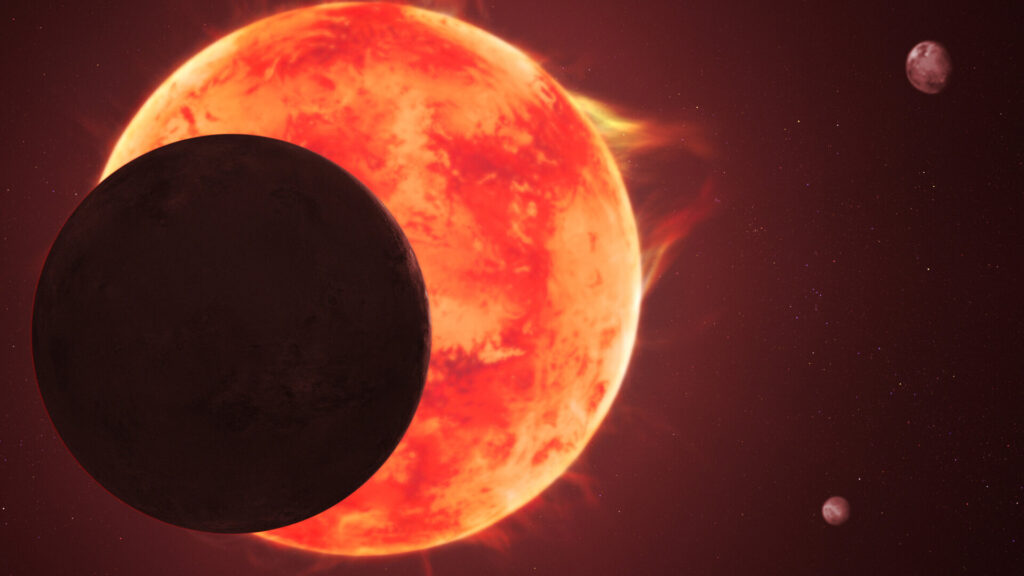
The exoplanet TRAPPIST-1 d, long considered a candidate for habitability due to its Earth-like size and location in a potentially life-supporting zone, has been found to lack an Earth-like atmosphere. This revelation comes from a new study utilizing data from the NASA/ESA/CSA James Webb Space Telescope, challenging previous hopes of finding a twin to our own planet beyond the solar system.
TRAPPIST-1 d is part of a fascinating system of seven Earth-sized planets orbiting a red dwarf star, located 40 light-years away. The system gained fame in 2017 as a record-holder for the most Earth-sized rocky planets around a single star. However, the latest findings suggest that TRAPPIST-1 d does not possess the atmospheric conditions necessary to support life as we know it.
The Quest for Earth-like Worlds
Earth’s unique environment, with its protective atmosphere, abundant liquid water, and stable climate, sets a high bar for habitability. The James Webb Space Telescope offers unprecedented capabilities to explore whether similar conditions exist elsewhere. The TRAPPIST-1 system, with its seven planets, presents a valuable opportunity to investigate this question, especially since it orbits a red dwarf, the most common type of star in the galaxy.
Caroline Piaulet-Ghorayeb of the University of Chicago and the Trottier Institute for Research on Exoplanets (IREx) at Université de Montréal, lead author of the study published in The Astrophysical Journal, emphasized the importance of this research.
“Ultimately, we want to know if something like the environment we enjoy on Earth can exist elsewhere, and under what conditions. While the James Webb Space Telescope is giving us the ability to explore this question in Earth-sized planets for the first time, at this point we can rule out TRAPPIST-1 d from a list of potential Earth twins or cousins,”
she stated.
The Challenges of Red Dwarf Orbits
The TRAPPIST-1 system’s red dwarf star poses significant challenges for its orbiting planets. Known for its volatility, the star frequently emits high-energy flares that can strip away atmospheres, particularly from planets in close proximity. TRAPPIST-1 d, the third planet from the star, sits on the edge of the habitable zone but is only 2% of Earth’s distance from the sun, completing an orbit in just four Earth days.
Webb’s NIRSpec (Near-Infrared Spectrograph) instrument failed to detect common atmospheric molecules such as water, methane, or carbon dioxide on TRAPPIST-1 d. However, Piaulet-Ghorayeb noted several possibilities for the planet’s atmospheric conditions, suggesting it might have an extremely thin atmosphere, similar to Mars, or thick clouds akin to Venus that obscure detection. Alternatively, it could be a barren rock devoid of any atmosphere.
Hope for the Outer Planets
Despite the setback with TRAPPIST-1 d, scientists remain hopeful about the outer planets in the system. Björn Benneke of IREx at Université de Montréal, a co-author of the study, highlighted the potential of planets e, f, g, and h. These planets, being further from the star, might retain their atmospheres, although their distance and colder environments make detection more challenging.
“Webb’s sensitive infrared instruments are allowing us to delve into the atmospheres of these smaller, colder planets for the first time,”
Benneke explained.
“We’re really just getting started using Webb to look for atmospheres on Earth-sized planets, and to define the line between planets that can hold onto an atmosphere, and those that cannot.”
Ryan MacDonald, a co-author of the paper now at the University of St Andrews, remains optimistic about the potential for discovery.
“All hope is not lost for atmospheres around the TRAPPIST-1 planets. While we didn’t find a big, bold atmospheric signature at planet d, there is still potential for the outer planets to be holding onto a lot of water and other atmospheric components,”
he said.
Implications for Future Research
The findings from TRAPPIST-1 d underscore the rarity of Earth-like conditions in the cosmos, reinforcing the special nature of our planet. However, the ongoing study of the TRAPPIST-1 system continues to offer valuable insights into the potential for life elsewhere in the universe.
The James Webb Space Telescope’s capabilities are just beginning to be realized, and as researchers continue to probe the atmospheres of distant worlds, they hope to uncover more about the conditions that might support life. The search for Earth-like planets is far from over, and each discovery brings us closer to understanding our place in the universe.







